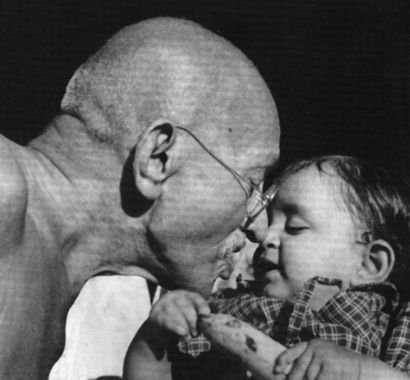
His journey towards Independence began in the early 1900s, when he started his involvement as a migrant from India in South Africa. In the years subsequent to the first World War, Gandhi matured in to the dignitary of India’s freedom struggle against Great Britain.
The Initial Days
Born on 2nd October 1869 at Porbandar, Gandhi’s father was the chief minister of the state. At 19 years of age, he left for London to study law in at the Inner Temple. After he came back to India in 1891, he took up a job with an Indian firm that transferred him to its South Africa branch. He set off to South Africa with his wife, Kasturba, and children and settled down there for up to two decades.
While in South Africa Gandhi was alarmed by the prejudice he had to go through because he was an Indian immigrant. On the event when a European officer in Durban demanded him to take off his turban, he rejected and exited the court. While journeying by train to Pretoria, he was cast off of the first-class coach and was beaten by a white stagecoach driver because he dismissed giving his seat to a European commuter. This incident was where Gandhi realized he had to raise his voice against the injustice, evolving and schooling the notion of satyagraha or passive resistance. This was to spark the idea of disobedience with the government.
The Beginning of Passive Resistance
In the year 1906, Gandhi guided a crusade of civil disobedience that lasted up to the subsequent 8 years. In 1913, amid its closing period scores of Indians in South Africa, got jailed. Many Indian miners were also arrested and killed. Eventually, due to crushing pressure from both the British and Indian authorities, the South Africa government had to undergo an agreement mediated by Gandhi and General Jan Christian Smuts. This negotiation consisted of essential adjustments for instance the acceptance of Indian marriages and the eradication of the current vote tax that only Indians had to pay.
Gandhi came back to India in July 1914. He then backed up the inclusion of the British in World War I, but along with this he stood against the authorities for the rules he thought were inequitable. 5 years later, he put in motion a drive of passive resistance to arise against the Parliament’s passage of the Rowlatt Acts. Under this act the provincial government had the capability to subdue riotous movements. Gandhi withdrew after rampage started, but this was only for a short while because by 1920 had become a prominent personality towards the campaign towards Indian independence.
The Outbreak of a Movement
To emphasize the principle of peaceful non-cooperation, Gandhi gave priority to the fiscal autonomy of India. He mainly supported the fabrication of khadi, to oust the imported cloth from Britain. The austere lifestyle of Gandhi had restored in him the admiration of his disciples. With the loyalty of the Indian National Congress Gandhi managed to transform the drive into an enormous movement. Under this they excluded products that were manufactured by the British and also the academies portraying British impact in India. After the break out of immense violence, Gandhi declared the stop of the resistance movement. The British officials seized Gandhi in March 1922, after which he was condemned to six years in jail.
The Prorated Movement
In 1931, after the British government underwent a few adjustments, Gandhi again discontinued the resistance drive. He bolstered the Congress Party at the Round Table Conference in London. On returning to a new intrusive colonial government, Gandhi initiated a string of hunger strikes to oppose how India’s ‘untouchables’ or poor classes were treated. The starvation uprooted his disciples and culminated in amends by the Hindu community.
The Passing of Gandhi
The Labor Party took control in Britain in the year 1947, and the bargaining over the Indian home rule started between the Congress Party, British and the Muslim. Successively in that year Britain acknowledged India its independence, however they also partitioned the country into two domains – India and Pakistan. Although Gandhi was vehemently against with this division, but he accepted in the prospect of national peace.
In 1947, even post the Partition, his work didn’t end and he commenced by attempting to create peace between Hindus and Muslims. This incurred to his death, and in January 1948 Gandhi was shot in Delhi by a Hindu zealot.
Most Fascinating Facts about Mahatama Gandhi
- He was nominated as many as 5 times for the Nobel Prize, but never received one.
- Mahatama Gandhi considered walking as the “prince of exercises” and walked for great distances mostly to save money when commuting in England and India. He admitted to having stayed away from illness during his stay abroad owing to his habit of walking.
- On an average Gandhi walked for as many as 18km for 40years of his life!
- Gandhi failed as a lawyer as his speeches or cross-questioning with witness gave him cold-feet owing to his shy nature.
- In 1947, Gandhi was not present at the speech of J.L.Nehru ‘Tryst with Destiny’ speech, nor did he take a moment to celebrate independence. Instead he was in Calcutta holding a fast and conducting a non-violence movement to stop the intense riots between East and West Bengal.
- Gandhi’s job in South Africa was amongst the most well-paid jobs of that time.
- In 1930, he was accorded “Man of the Year” title by TIME magazine. To date he has been the only Indian to have received the honor.
- Gandhi was conferred with the tag “Mahatama” by Rabindranath Tagore, meaning “high-soul”.
- Mahatama Gandhi was not only an inspiration for world leaders like Nelson Mandela & Martin Luther but also stimulated civil rights movement in 4 continents and 12 countries!
- Netaji Subhash Chandra Bose entitled Gandhi as ‘The Father of the Nation’ when he marched Indian National Army to Delhi in 1944.







